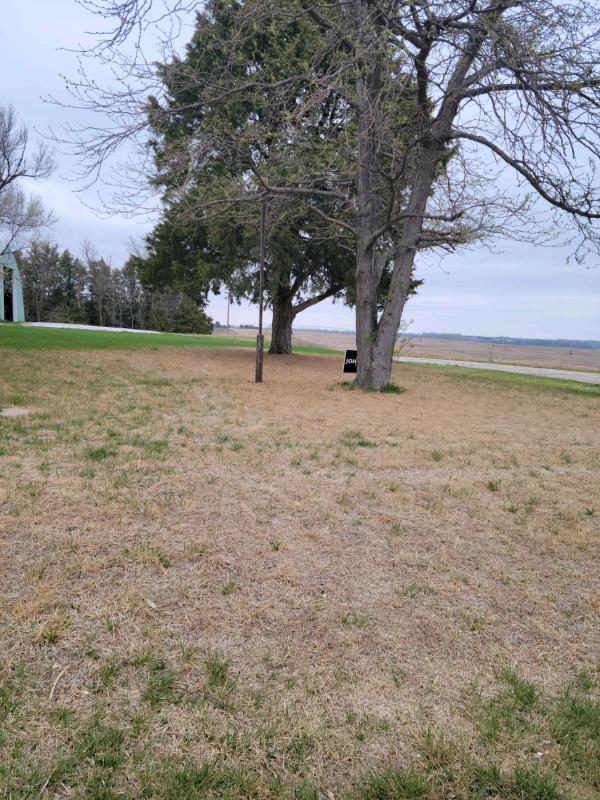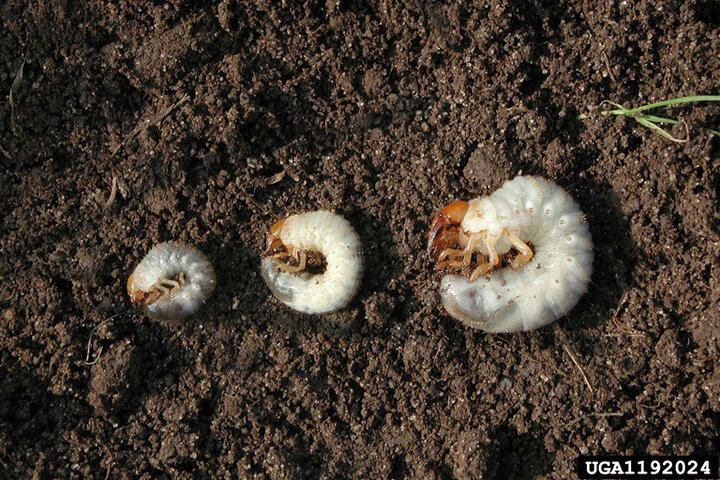Sarah Browning, Nebraska Extension Educator

Severe winter damage to Kentucky bluegrass/ tall fescue lawn. Image used with permission from Adams County client.
This spring, some of our lawns look beautiful and others are showing some winter damage. The dry conditions we experienced from September through March have caused patchy grass death in some locations, especially south or west facing sites exposed to wind. Here in eastern Nebraska, cool season grasses like Kentucky bluegrass and tall fescue should be fully green now. So if your cool season lawn has some brown patches – and it’s not zoysia grass - the lawn may have experienced some winter desiccation injury. What should be done? Let’s look at this to and a few other common questions for lawn managers in spring.
Lawn Seeding
First, has your lawn has been treated with a preemergent herbicide? If so, which product was used will determine if a grass seeding now will be successful. Mesotrione and siduron (Tupersan) are the only preemergent chemicals that can be used on lawns to be seeded this spring. Both kill germinating crabgrass and foxtail, but will not kill germinating Kentucky bluegrass or tall fescue seeds.
Mesotrione is the active ingredient in Scott’s Turf Builder Triple Action Built for Seeding and is one of the most common homeowner products in stores which can be used for new seedings.
If any other preemergent was used – including prodiamine, benefin, balan, dithiopyr – germinating grass seeds will be killed along with weed seeds. Check the active ingredient statement on the product you used to determine the preemergent chemical. Or call your lawn care provider for the name of the product they applied.
If one of these preemergents was applied, when can seeding be done? It depends on the product used and the rate applied. Since summer seedings are difficult and less successful, the better course is to overseed in fall seed – August 15 to September 15.
Sodding
If the damaged area is large or in a very noticeable location, sodding is another option. Remove the dead grass, and regrade the area if necessary, so the new sod can be laid on bare soil. Sod can be laid anytime the soil is not frozen.
Establishing Lawns from Sod, UNL Turf iNfo.

White Grub Control
“When should I apply control for white grubs?” is a common spring question for many home lawn managers. It’s still too early for this application yet, the ideal time is mid to late June.
The term "white grub" encompasses the larval stage of several scarab beetles, the most common, and most damaging, being the June beetle or masked chafer and the Japanese beetle. Both masked chafers and Japanese beetles have a 1-year lifecycle.
- Adult June beetles are stout bodied, oval-shaped insects, about 1/2 inch in length, and dark yellow to light brown in color. They are most active at night and, unlike other scarab beetles, do not feed on plants as adults.
- Japanese beetle adults are slightly smaller, only 3/8 inches in length, with a dark metallic green head and coppery-brown body. They also have 5 tufts of white hairs on the sides of their abdomen.
- Less well-known are the May/June beetle, green June beetle, Asiatic garden beetles, oriental beetles, European chafers and black turfgrass Ataenius. Each of these scarab species has a unique biology and life cycle requiring a specific management approach, but they all have a grub larval stage that can cause damage to turfgrass.
The grubs are off white, with six legs located just behind their reddish-brown head and are usually found curled into a "C" shape in the soil. Any grubs found now are mature, not feeding much so cause little damage and relatively difficult to kill. For those reasons, we target the next generation of young grubs which will hatch in late June or early July.
White grubs feed on turf roots and other organic matter in the soil. They damage grass by destroying roots and eliminating plants’ ability to pull up water from the soil. Initially small patches of grass, usually in hot sunny areas, turn brown and die. Damage symptoms are usually at their worst in late July and early August if high insect numbers are present and not controlled.
Preventive Control - Most of the preventively-applied insecticides are systemic in nature and will be taken up by the plant and translocated to the root zone where the grubs are active. All the following products are very effective against young grubs. Labels: c=commercial product, h=homeowner product.
- Chlorantraniliprole – Acelepryn(c), Scotts GrubEx (h)
- Clothianidin – Arena (c)
- Halofenozide - Mach 2 (c)
- Imidacloprid – Merit (c), Bonide Grub Beater (h), BioAdvanced Season Long Grub Control Plus Turf Revitalizer (h)
- Thiamethoxam – Meridian (c)
Effective control depends on moving the insecticide down to the root zone where the grubs are feeding. Excess thatch reduces effectiveness by reducing the movement of insecticide to the soil. If the thatch layer in your lawn exceeds ½ inch, there is still time for spring aeration to reduce it.
Image:
- Depicted are 3 species, among the pest complex called "white grubs." The photo is useful as a comparison for size and appearance of these. The species L to R are: Japanese beetle, Popillia japonica;European chafer, Amphimallon majalis; and June bug, Phyllophaga sp. Photo by David Cappaert.